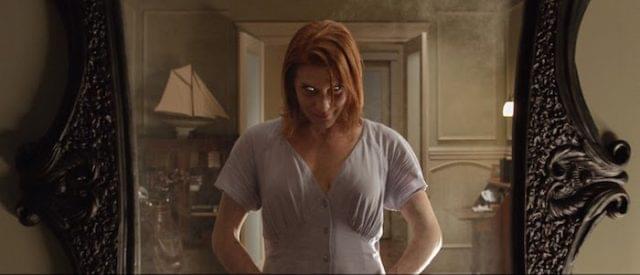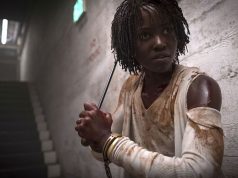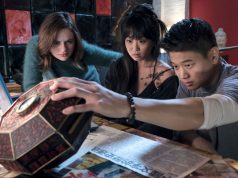
The first thing you should know about “Oculus,” a horror film about a haunted mirror, is that it is much better than a film about a haunted mirror has any right to be. Directed, co-written, and edited by Mike Flanagan, it’s an expansion on a well-received 30-minute short he made several years ago, and the extra practice he’s had at getting it right is evident in the way he creates atmosphere and builds suspense.
It also helps that the characters are smart, by which I mean they do what WE would do if WE were faced with a haunted mirror. At several points in the story you’ll nod and smile and think, “Yes! Good idea,” and then be scared pantsless when it doesn’t work after all.
The evil mirror in question is an ostentatious antique from the 1700s that fell into the hands of the Russell family 11 years ago. At the moment, 21-year-old Tim Russell (Brenton Thwaites) has just been released from a mental facility where he’s lived since the events that happened when he was 10. His older sister, Kaylie (Karen Gillan), has been waiting for him to get out so he could help her fulfill the promise they made as children: to “kill it,” “it” being the mirror and “kill” being undefined. (No, they can’t just smash it. The film addresses that question satisfactorily.) What happened all those years ago is revealed soon enough in basic terms (suffice it to say it was tragic) and shown to us in detail as Flanagan smoothly jumps back and forth between the two timelines.
In the past, young Kaylie (Annalise Basso) and Tim (Garrett Ryan) see their father (Rory Cochrane) and mother (Katee Sackhoff) gradually undone by what the kids realize are sinister forces associated with the mirror that hangs in Dad’s home office. Now, the mirror doesn’t jump down off the wall and go around killing people, obviously. Don’t be silly. What it does is mess with your mind. It’ll make you want to do something you wouldn’t normally do, or make think you’re doing one thing when you’re actually doing something else. For example, maybe you think you’re pulling a Band-Aid off your finger, but you’re really yanking out the fingernail. Or maybe you think you’re giving the kids a bath, but you’re actually — well, you get the idea.
In the present, Kaylie is determined to prove that the terrible things that happened in their home 11 years ago were caused by the mirror, and that the people who did the actual deeds were not responsible for their actions. (She has a long list of gruesome fates met by the mirror’s previous owners over the years.) With video cameras running and safeguards in place to stave off the mirror’s trickery, she and Tim begin the experiment.
Tim is reluctant, though. He’s spent the last decade being “cured” of the delusion that a haunted mirror is to blame for what happened to their family, and he tries to convince Kaylie that their childish imaginations simply got the best of them. As for us, while there is mystery in the film, it’s not centered on the question of whether the mirror is genuinely haunted. There’s little room for doubt on that subject. The question is how — and whether — Kaylie can capture evidence of it and then destroy the thing before it kills again.
Telling a story about a mirror that plays mind games means Flanagan gets to play mind games too. We see Tim and Kaylie’s actual memories, plus their mirror-induced hallucinations of memories, plus their hallucinations of what’s happening now, tonight. Flanagan revels in keeping us as off-balance as the characters are, not letting us figure out what’s real any sooner than Tim and Kaylie do.
Covering both timelines at once allows for parallel climaxes set in the same house in different years. Though the tension of the flashback story is diminished somewhat by our already knowing (essentially) how it ends, Flanagan cuts between them expertly, letting the past and present bleed together. Gillan, Sackhoff, and Cochrane give sharp performances (Thwaites is a bit of a lightweight) as the darkness unfolds in both timelines. It’s almost like getting two effective, creepy stories in one.
B (1 hr., 45 min.; )
Originally published at About.com.





